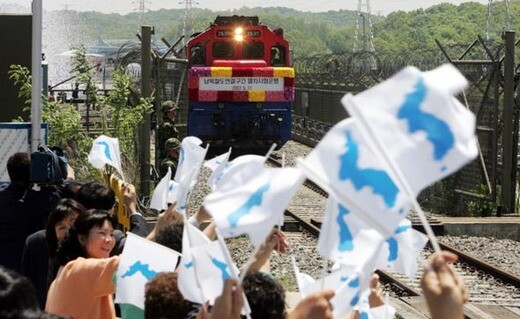hankyoreh
Links to other country sites 다른 나라 사이트 링크
Inter-Korean train lines tested, so what now?

The May 17 test of two train lines that cross the border between the two Koreas is being called a one-time event, as prospects are unclear when the next train will cross the border again, and no timetable has been set between the two Koreas to formally reconnect their railways.
However, as South Korea’s Unification Minister Lee Jae-jung estimated the test-run as a "precious first step on a long journey," the trial run was a stepping stone to eventually build the Trans-Korea Railway and then a railroad connecting the Korean peninsula to the Eurasian continent.
On May 14, the South Korean government said it would gradually and partially reconnect the railways. The government’s three-stage plan first aims to ship raw materials to the Kaesong (Gaeseong) Industrial Complex from the South and serve as transportation for the North Korean workers from their living quarters to the industrial park. Then, the government plans to extend the use of the railways to serve South Korean tourists and workers at the Kaesong industrial park. A third-stage plan is to have a regular railway running between Seoul and Pyongyang.
The unification minister also commented on May 17 about possible travel to the North’s Mount Geumgang tourism complex by train.
Lee’s remarks coupled with the government’s plans signal Seoul’s gradual approach to using the 27.3-kilometer Gyeongui line (Munsan-Kaesong) and the 25.5-kilometer Donghae line (Jejin-Mt. Kumgang) on the east side of the peninsula.
The government has for now backed down on their ambitious vision of connecting the railways with the Trans-Siberia Railway and the Trans-China Railway as well as modernizing the North’s aging tracks.
While North Korean workers at the Kaesong Industrial Complex are banned from traveling to the South by train, the test-run was meaningful because the railway is slated to be used at the complex, core inter-Korean economic cooperation project. Because of traffic jams when the more than 13,000 North Korean workers are bused to and from work, the North is not negative to the idea of using the railway for their commute, a South Korean government official said.
However, the South’s plan to reconnect an inter-Korean railway based on the Gyeongui line (Seoul-Pyongyang line) may face compromises and revisions. Unlike the South, the North wants to reconnect the railway based on the Donghae (east coast) line. A 2002 agreement to reconnect the Donghae line was forged because of North Korean leader Kim Jung-il’s willingness toward the project, former unification minister Lim Dong-won said.
The North’s attitude is mainly due to concerns that the Trans-Korea Railway based on the Gyeongui line may pose a negative impact on its regime’s security because the line would cross through major cities, including Pyongyang. In contrast, the Donghae line travels through sparsely populated regions. After all, to materialize the dream of building the Trans-Korea Railway, stabilization of the situation on the Korean peninsula is necessary to let North Korea reform and open its country.
In the wake of the successful test-run of inter-Korean railways, a new wave of inter-Korean economic projects is slated to begin next month by exchanging raw materials for light manufacturing from the South with mineral resources from the North.
Please direct questions or comments to [englishhani@hani.co.kr]
Editorial・opinion
![[Column] Park Geun-hye déjà vu in Yoon Suk-yeol [Column] Park Geun-hye déjà vu in Yoon Suk-yeol](https://flexible.img.hani.co.kr/flexible/normal/500/300/imgdb/original/2024/0424/651713945113788.jpg) [Column] Park Geun-hye déjà vu in Yoon Suk-yeol
[Column] Park Geun-hye déjà vu in Yoon Suk-yeol![[Editorial] New weight of N. Korea’s nuclear threats makes dialogue all the more urgent [Editorial] New weight of N. Korea’s nuclear threats makes dialogue all the more urgent](https://flexible.img.hani.co.kr/flexible/normal/500/300/imgdb/original/2024/0424/7317139454662664.jpg) [Editorial] New weight of N. Korea’s nuclear threats makes dialogue all the more urgent
[Editorial] New weight of N. Korea’s nuclear threats makes dialogue all the more urgent- [Guest essay] The real reason Korea’s new right wants to dub Rhee a founding father
- [Column] ‘Choson’: Is it time we start referring to N. Korea in its own terms?
- [Editorial] Japan’s rewriting of history with Korea has gone too far
- [Column] The president’s questionable capacity for dialogue
- [Column] Are chaebol firms just pizza pies for families to divvy up as they please?
- [Column] Has Korea, too, crossed the Rubicon on China?
- [Correspondent’s column] In Japan’s alliance with US, echoes of its past alliances with UK
- [Editorial] Does Yoon think the Korean public is wrong?
Most viewed articles
- 1[Column] Park Geun-hye déjà vu in Yoon Suk-yeol
- 2Thursday to mark start of resignations by senior doctors amid standoff with government
- 3N. Korean hackers breached 10 defense contractors in South for months, police say
- 4Kim Jong-un expressed ‘satisfaction’ with nuclear counterstrike drill directed at South
- 5[Editorial] New weight of N. Korea’s nuclear threats makes dialogue all the more urgent
- 6Will NewJeans end up collateral damage in internal feud at K-pop juggernaut Hybe?
- 7[Column] ‘Choson’: Is it time we start referring to N. Korea in its own terms?
- 8[Editorial] Japan’s rewriting of history with Korea has gone too far
- 9[Cine feature] A new shift in the Korean film investment and distribution market
- 10[Column] The president’s questionable capacity for dialogue